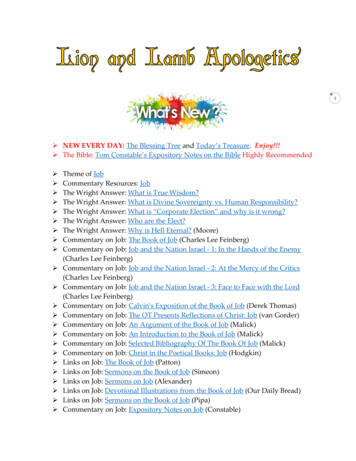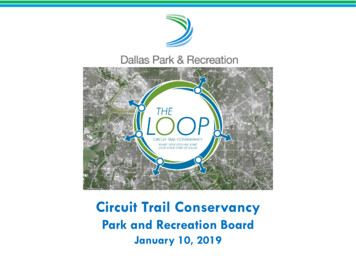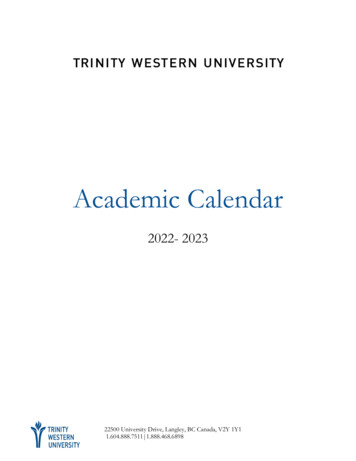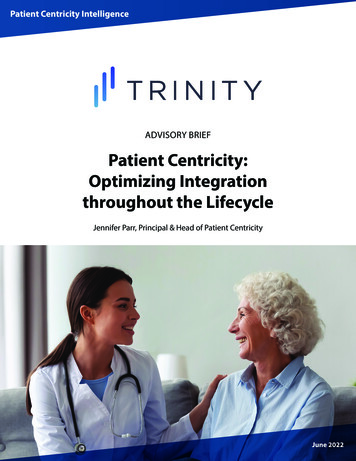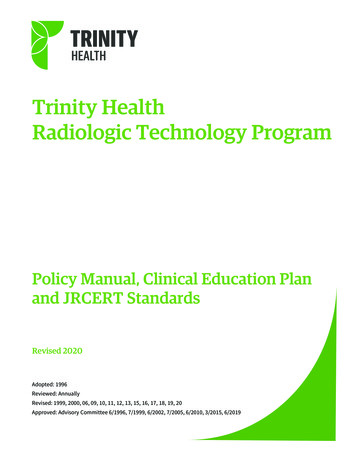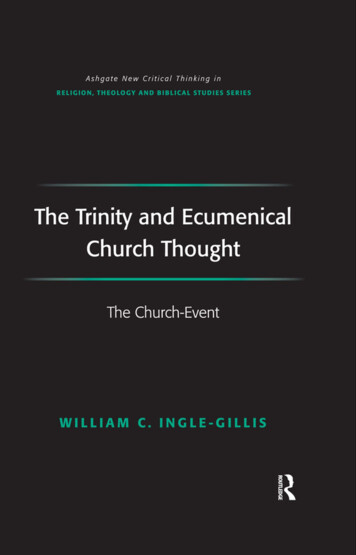
Transcription
The Trinity and EcumenicalChurch ThoughtSome hundred years from inception, the ecumenical movement is stagnating. WilliamC. Ingle-Gillis argues that the problem lies in modern ecumenism’s treatment ofdenominational Churches as provisional entities requiring reunion to be morefully Christ’s Body. In a work unique both to ecumenical studies and to trinitariantheology, the author redefines ecclesial life from the premise that God’s essence ispersonhood-in-communion and that the ultimate calling of human persons is to shareas fully in the divine life as Christ himself.Concluding that the Churches are, by the Spirit’s action, a tangible, dynamic event,wherein God makes visible his on-going reconciliation of the world to himself,Ingle-Gillis argues that the Churches’ true life lies in coming-together, rather thanbeing-together. This conclusion places ecumenism at the heart of Church life andwitness.
Ashgate New Critical Thinking in Religion,Theology and Biblical StudiesThe Ashgate New Critical Thinking in Religion, Theology and Biblical Studies seriesbrings high quality research monograph publishing back into focus for authors,international libraries, and student, academic and research readers. Headed by aninternational editorial advisory board of acclaimed scholars spanning the breadth ofreligious studies, theology and biblical studies, this open-ended monograph seriespresents cutting-edge research from both established and new authors in the field.With specialist focus yet clear contextual presentation of contemporary research,books in the series take research into important new directions and open the field tonew critical debate within the discipline, in areas of related study, and in key areasfor contemporary society.Series Editorial Board:Jeff Astley, North of England Institute for Christian Education, Durham, UKDavid Jasper, University of Glasgow, UKJames Beckford, University of Warwick, UKRaymond Williams, Wabash College, Crawfordsville, USAGeoffrey Samuel, University of Newcastle, AustraliaRichard Hutch, University of Queensland, AustraliaPaul Fiddes, Regent’s Park College, University of Oxford, UKAnthony Thiselton, University of Nottingham, UKTim Gorringe, University of Exeter, UKAdrian Thatcher, College of St Mark and St John, UKAlan Torrance, University of St Andrews, UKJudith Lieu, Kings College London, UKTerrance Tilley, University of Dayton, USAMiroslav Volf, Yale Divinity School, USAStanley Grenz, Baylor University and Truett Seminary, USAVincent Brummer, University of Utrecht, The NetherlandsGerhard Sauter, University of Bonn, GermanyOther Titles in the Series:Engaging Deconstructive TheologyRonald T. MichenerThe Politics of PraiseNaming God and Friendship in Aquinas and DerridaWilliam W. Young III
The Trinity and EcumenicalChurch ThoughtThe Church-EventWilliam C. Ingle-GillisThe Church in Wales, UK
First published 2007 by Ashgate PublishingPublished 2016 by Routledge2 Park Square, Milton Park, Abingdon, Oxon OX14 4RN711 Third Avenue, New York, NY 10017, USARoutledge is an imprint of the Taylor & Francis Group, an informa businessCopyright William C. Ingle-Gillis 2007All rights reserved. No part of this book may be reprinted or reproducedor utilised in any form or by any electronic, mechanical, or other means,now known or hereafter invented, including photocopying andrecording, or in any information storage or retrieval system, withoutpermission in writing from the publishers.Notice:Product or corporate names may be trademarks or registered trademarks,and are used only for identification and explanation without intent toinfringe.William C. Ingle-Gillis has asserted his moral right under the Copyright, Designs and PatentsAct, 1988, to be identified as the author of this work.British Library Cataloguing in Publication DataIngle-Gillis, William C.The Trinity and ecumenical church thought : the church-event. – (Ashgate new criticalthinking in religion, theology and biblical studies)1. Christian union 2. TrinityI. Title280'.042Library of Congress Cataloging-in-Publication DataIngle-Gillis, William C., 1968–The Trinity and ecumenical church thought : the church-event / William C. Ingle-Gillis.p. cm.—(Ashgate new critical thinking in religion, theology, and biblical studies)Includes bibliographical references (p.) and index.iSBn 0-7546-5742-6 (hardcover : alk. paper)1. Christian union. 2. Trinity. I. Title. II. Series.BX8.3.I55 2007262.001'1—dc222006008826iSBn 9780754657422 (hbk)
For Heidi and Mum,who were always there.And for Isaac,who mostly just sat in my lapand grabbed at the telephone.
ContentsAcknowledgements List of abbreviations ixxiPart 1 The provisionalist ecclesiology of modern ecumenism1 Ecumenism and ecclesiology 2 Survey of ecumenical provisionalism 331Part 2 Trinitarian ontology: the ecclesiological cornerstone3 Principles of trinitarian ontology and cosmology 4 The Spirit in the economy of being and salvation 5783part 3 Event-ecclesiology and -ecumenism5 Ecclesiological principles 6 Event-ecclesiology: a response to provisionalism 123161Bibliography Index 197215
AcknowledgementsAs any author knows, the writing of a book is almost by definition an act ofcommunion: the efforts of the one depend so distinctly upon the faithfulness andgood will of the many if the whole is to come to fruition. My own many, who areindeed many, have made all the difference:To Brian Horne I owe a profound debt of gratitude not only for challenging mymind so deeply in the course of many conversations, but also for the utter freedomwith which he gave of himself personally during the writing process. His generosityhas meant more to me than he likely knows. Richard Burridge too has offeredunflagging support – personally, pastorally and professionally. I know all too wellthat without his abiding friendship I could never have come this far.Amongst my peers Justyn Terry and Michael Peat deserve special mention,having given much energy to discussing myriad draft chapters and exploratorypapers. Without their camaraderie in plumbing the depths of my subject – without somany ideas generated through hours of bright, lively conversation – the work wouldhave been far less rich, the production far less rewarding.Sometimes, however, in the midst of the lonely business of putting pen to paperin the wee hours, a writer just needs mates to put things in perspective over a pintand a fag. I have been blessed with plenty, most especially Tim Pryse-Hawkins,Charlie Gibson, Caroline Shrieve, James Rawling (requiescat in pace), Eddie Greenand Emma Antoine – friends, all, of the finest kind, who walked with me faithfullythrough triumph and trial.Likewise, Thaddeus Birchard, Richard Pain, Rowan Williams, Vicky Raymerand Lyndon Harrison – each in his or her own way, all with great kindness and caring– have given me critical support of a different kind: the unique roles that each ofthem has played in the ongoing formation of my life’s ministry have made visible thelight at the end of the tunnel when light was so desperately needed.Finally and without doubt most importantly I thank God daily for my family,most especially for Heidi and Mum, without whose steadfast, selfless love – andencouragement at any and all hours of day or night – none of this would ever havecome to pass. I never deserved such blessing.Nuestra Señora de Guadalupe, ruega por nosostros.
List of abbreviationsALC Anglican-Lutheran CommissionALJC Anglican-Lutheran Joint CommissionAOJDC Anglican-Orthodox Joint Doctrinal CommissionARCIC-I[First] Anglican-Roman Catholic International CommissionARIC Anglican-Reformed International CommissionBCJohn D. Zizioulas, Being as CommunionBEMFaith and Order Commission, Baptism, Eucharist, MinistryBTRColin E. Gunton, A Brief Theology of RevelationBWABaptist World AllianceBYMQ Yearly Meeting of the Religious Society of Friends (Quakers) inBritainC&SKarl Rahner, The Church and the SacramentsCD[vol.]Karl Barth, Church Dogmatics [vol.]‘ChE’ Colin E. Gunton, ‘The Church on Earth’CiCPaul Avis, Christians in CommunionCoE Church of EnglandD&CThe Doctrine and CovenantsD&COThomas F. Torrance, Divine and Contingent Order‘DHT’John D. Zizioulas, ‘The Doctrine of the Holy Trinity’DeIncar Athanasius, On the Incarnation of the WordDeSpSBasil of Caesarea, On the Holy SpiritECG Evangelical Church in GermanyEcuPatr Ecumenical PatriarchateFCKarl Barth, The Faith of the ChurchF&OFaith and Order CommissionECF/NPNEarly Church Fathers, Nicene and Post-Nicene FathersELCA Evangelical Lutheran Church in AmericaJWGJoint Working Group Between the Roman Catholic Church and theWorld Council of ChurchesLC[year] Lambeth Conference [year]MCThomas F. Torrance, The Mediation of ChristMCGB Methodist Church of Great BritainMembersWorld Council of Churches, World Council of Churches MemberChurches, Associate Member Churches and National CouncilBodiesn.d.no date of publication givenn.p.no place of publication givenNPCFaith and Order Commission, The Nature and Purpose of theChurchn.v.no volume number given
xiiThe Trinity and Ecumenical Church Thought‘OBP’John D. Zizioulas, ‘On Being a Person’OORD Oriental Orthodox-Reformed DialogueOT&M Colin E. Gunton, The One, the Three and the ManyPGPThe Pearl of Great Price‘PrCh’John (Zizioulas) of Pergamon, ‘Primacy in the Church’PTT Colin E. Gunton, The Promise of Trinitarian TheologyQFP(UK) Yearly Meeting of the Religious Society of Friends (Quakers) inBritain, Quaker Faith and PracticeRCC Roman Catholic ChurchRCLJC Roman Catholic/Lutheran Joint CommissionST&IThomas F. Torrance, Space, Time and IncarnationTrCr Colin E. Gunton, The Triune CreatorTrinFThomas F. Torrance, The Trinitarian Faith‘TrinFdn’Thomas F. Torrance, ‘The Trinitarian Foundation and Character ofFaith and of Authority in the Church’TTT Christoph Schwöbel, ed., Trinitarian Theology Todayu.e.d.unpaginated electronic documentU&UC United and Uniting Churches ConsultationVat. IISecond Vatican CouncilWARCWorld Alliance of Reformed ChurchesWCCWorld Council of ChurchesWCC-EO-OOC World Council of Churches-Eastern Orthodox-Oriental OrthodoxConsultationY&T Colin E. Gunton, Yesterday and Today
PART 1The provisionalist ecclesiology ofmodern ecumenism
Chapter 1Ecumenism and ecclesiologyIntroduction: the modern ecumenical challengeGathered at the Lambeth Conference of 1920 the diocesan bishops of the AnglicanCommunion issued An Appeal to All Christian People. The encyclical’s prophetictone embodied a profound hope, not uncommon amongst modern ecumenism’searliest advocates, that the Churches of Christ then stood at the cusp of a new erain Christian history. The twentieth century like none other before was to be anecumenical century: one in which the bitter disputes of the past would finally giveway to the reunion of all believers into one common flock united within a single fold.‘The times’, proclaimed the bishops,call us to a new outlook and new measure. The Faith cannot be adequately apprehendedand the battle of the Kingdom cannot be worthily fought while the body is divided, andis thus unable to grow up into the fulness of the life of Christ. The time has come, webelieve, for all the separated groups of Christians to agree in forgetting the things whichare behind and reaching out towards the goal of a reunited Catholic Church .The vision which rises before us is that of a Church, genuinely Catholic, loyal to all Truth,and gathering into its fellowship all ‘who profess and call themselves Christians’, withinwhose visible unity all the treasures of faith and order, bequeathed as a heritage by thepast to the present, shall be possessed in common, and made serviceable to the wholeBody of Christ. History would suggest that, despite the bishops’ belief in the novelty of theirappeal, the Lambeth proposal did not so much herald a unique development as amodern expression of Christianity’s age-old struggle for unity. ‘Is Christ divided?’,demands the Apostle Paul himself to his feuding flock in Corinth (1 Cor. 1:13, AV). ‘Was Paul crucified for you?’, he laments, this self-same Paul whose quarrels withthe Judaisers of Antioch had required for resolution a full apostolic council (Acts 15,Gal. 2:1–14) – convened by the same disciples who once had bickered over seats inthe coming Kingdom before Christ ended the matter on his own cryptic terms (Matt.20:20–8, Luke 22:24–30). The contradictory realities of fractious humanity and theGospel’s communion-imperative have plagued Christian society from its inception. Lambeth Conference 1920, An Appeal to All Christian People, in ‘ResolutionsFormally Adopted by the Conference of 1920’, in Encyclical Letter from the Bishops, with theResolutions and Reports, 2d edn (London, 1920), §IV, res. 9. Biblical quotations are taken from the New Jerusalem Bible unless otherwiseindicated.
The Trinity and Ecumenical Church ThoughtIndeed throughout the course of two Christian millennia, wherever dissensionhas been found the ecumenical challenge has appeared as a constant imperative.Despite generation after generation of religious war and persecution, bitterness andrecrimination, anathema and propaganda, the ‘heretic’ has rarely been classifiedin precisely the same category as the ‘infidel’. Even in the most polemic of timesseparated Nicene communities have often recognized a common bond, howevertenuous. Time and again the Churches have undertaken to explore the theology ofthat bond and to give it more visible expression.A smattering of illustrations might include Augustine’s laborious efforts torestore communion with the Donatists, the sporadic bargains struck from the fifth tothe seventeenth centuries between Chalcedonians and non-Chalcedonians, the shortlived restorations of Orthodox-Catholic communion at the Councils of Lyons andFlorence, doctrinal bargaining amongst Lutheran and Reformed communities duringthe Reformation’s formative period, the nineteenth-century Oxford Movement’sovertures to Rome and Constantinople.Yet if the drive for reunion is not unique to modern times, the Anglican bishops’sense of urgency, seen in retrospect, was not out of place. The twentieth century wasto be marked by staggering political, social and religious turbulence which altered allChurches’ involvement with the world and with one another on the deepest levels. Inthe century’s first half the collapse of the ‘old world’ European empires, punctuatedby two world wars, spelled the end of the political protection under which the westernChurches’ missions had spread. The second half, dominated by Cold War ideologicalbattles, saw in the West the marked rise of secularism that rapidly marginalizedChristianity’s societal influence and in the East produced outright persecution of allreligions under state-sponsored atheism.The present day has brought new challenges. In the aftermath of the SovietUnion’s collapse many Eastern Churches struggle, with severely limited resources,to respond to massive social changes and new religious equilibria in their homelands.In historical trouble-spots the world over the decay of Cold War alliances has revivedmilitant nationalism, which often has co-opted religious belief into its service. In theWest free-market triumphalism offers up the Cult of the Almighty Dollar for ‘alltimes and all places’ – even times of economic recession – with the stock market asthe temple for adoration. Throughout the world increasingly sophisticated transportsystems have facilitated extensive migrations of large populations, whilst advancingcommunication and information technology has created an ever-freer globalexchange of ideas. Together these trends have fostered the growth of multi-cultural,multi-ethical societies – no bad development in itself, but nonetheless one in whichthe Churches often struggle to find a meaningful voice.Few of these dramatic upheavals had transpired when the Lambeth Appeal wasissued, nor could many have been accurately predicted. But significant societaltransformations were already evident in seminal form, and modern ecumenismconstituted a notable aspect of the Churches’ response. ‘About the ecumenicalmovement, there is a certain historical inevitability’; so argue Anthony and Richard
Ecumenism and ecclesiology Hanson. The familiar ‘truths’ of Victorian-era empires, philosophies and ideologieswere fast fading. In fact the Hansons argue that some ‘truths’, such as the intimateChurch-state bond forged during the Reformation, had actually begun to atrophydecades before. If the twentieth century yet held many a surprise in store, theChurches already had some premonition of challenges forthcoming, not least from agrowing indifference to theism in Europe and the failure of traditional denominationalpolemics to excite in non-European societies the same passions or sense of identitythat they aroused in their lands of origin.The Churches of the early 1900s began to recognize that denominationalisolationism and factional infighting were a liability to fulfilling Christ’s mandateto engage the world and make disciples of all nations (Matt. 28:19). They beganto discern the need to enhance whatever recognition of common faith and ministryalready existed amongst them, to overcome doctrinal disputes and excommunicatestatus and to look towards one another for support rather than competition. By theclose of the twentieth century’s first decade, three world mission conferences – inLondon (1888), New York (1900) and Edinburgh (1910) – had begun to lay thefoundations of a new phase of ecumenism in large part by challenging the crediblewitness and practical efficacy of separated, bickering faith-communities whose coreproclamation was the Gospel’s healing power, the restoration of the sinner and theunity of God and humanity in the Lord Jesus Christ. ‘It can be said’, writes JohnPaul II,that the ecumenical movement in a certain sense was born out of the negative experienceof each one of those who, in proclaiming the one Gospel, appealed to his own Churchor Ecclesial Community. This was a contradiction which could not escape those wholistened to the message of salvation and found in this fact an obstacle to acceptance ofthe Gospel. Thus, out of a certain practical necessity was born modern ecumenism.Development and characteristics of modern ecumenismFrom these pragmatic beginnings the process of rapprochement, although by no meanscomplete, has been remarkably swift, given the depth of Christianity’s divisions. The A.T. and R.P.C. Hanson, The Identity of the Church: A Guide to Recognizing theContemporary Church (London, 1987), p. 39. Ibid. Mary Tanner, What is Faith and Order, paper prepared for Faith and OrderConsultation with Younger Theologians, Turku, Finland, 1995, online edn, par. 4. See ThomasA. Askew, ‘The 1888 London Centenary Missions Conference: Ecumenical Disappointmentor American Missions Coming of Age?’, International Bulletin of Missionary Research 18(July 1994): 113–18; the 1888 Conference, Askew argues, represented an intermediate stagein the Churches’ transition from paternalistic religious wings of colonial empires to modernecumenical communities. John Paul II, Christian Unity: Encyclical Letter Ut unum sint of the Holy Father JohnPaul II on Commitment to Ecumenism (Sherbrooke, Québec, 1995), par. 23.
The Trinity and Ecumenical Church Thoughtinitial flurry of letters and encyclicals such as the Lambeth Appeal, meant both to testthe ecumenical waters and to propose terms of engagement, were quickly followedby resolutions committing Churches to ecumenical work, preliminary theologicalinvestigations, prototypical intercommunion proposals and a handful of actualagreements amongst like-minded Churches. With the advent of the InternationalMissionary Council (IMC) in 1921, the first Life and Work Conference (L&W)in 1925 and the Faith and Order Conference (F&O) of 1927, modern ecumenismgained its first permanent institutions which, given the participation not only ofthe major Protestant denominations and Anglicans but also of Orthodox and OldCatholics, began to assume universal proportions, incorporating as it did elements ofall major Christian traditions, although not yet the Church of Rome itself. By 1948the latter two structures had coalesced into the World Council of Churches (WCC),which at its Delhi Assembly of 1961 would incorporate the IMC as well. Finallyin the mid-1960s the Second Vatican Council committed Rome ‘irrevocably’, inJohn Paul’s words, to the ecumenical project and culminated in the December 1965retraction of the excommunications in force since 1054 between Catholicism andEastern Orthodoxy. These developments together with increasing local involvementin ecumenical projects have helped to establish amongst mainstream Christianity thegoal of reunion and the imperative of common mission as critical fixtures of modernChurch life.Today the WCC remains the most visible and central institutional expression ofthe ecumenical project. Counting its denominational membership at around 340,it includes many Churches from the mainstream Protestant traditions, a majorityof Eastern and Oriental Orthodox Churches, a growing number of conservativeevangelicals and pentecostals, many of the ‘new’ Churches now exploding outof Africa and of course the ‘United and Uniting’ Churches, the movement’s mostconspicuous fruit. (Notably, many in the last two categories arose in the samemissionary venues in which Church division had proven a hindrance.) Although theRoman Catholic Church has never formally sought membership, it too has becomecritical to Council policy, programmes and studies through its Joint Working Groupand full, lively membership in the Faith and Order Commission. Statistics aside, theecumenical spirit has come far from the days in 1920 when the Lambeth bishopscould see their vision only far in the distance. Today the ecumenical proclamations G.K.A. Bell, ed., Documents on Christian Unity: 1920-4 (Oxford, 1924) offers a broadcollection of early ecumenical correspondence, statements, encyclicals and agreements. John Paul II, par. 3; see Edward Yarnold, They Are in Earnest: Christian Unity in theStatements of Paul VI, John Paul I, John Paul II (Slough, 1982), p. 67; Methodios Fouyas,Orthodoxy, Roman Catholicism and Anglicanism (London, 1972), pp. 214ff. Note that the WCC, although of pivotal importance, represents only one stream of themovement; some evangelicals and pentecostals, wary of the WCC’s ‘liberal’ methodology,have employed parallel structures since 1974; see ch. 1, n. 20, below. Additionally Eastern andOriental Orthodox have lately expressed deep disquiet about their perception of a prevailingProtestant ethos in the Council; see [World Council of Churches-Eastern Orthodox-OrientalOrthodox Consultation], Common Understanding and Vision of the WCC: WCC Consultationwith Its Orthodox Member Churches [Chambésy Statement 1995], in The Ecumenical Review48 (Apr. 1996), online edn: u.e.d., especially par. 7.
Ecumenism and ecclesiology are much more confident, as F&O’s Fifth World Conference message illustrates: ‘Wesay to the churches: there is no turning back, either from the goal of visible unity orfrom the single ecumenical movement that unites concern for the unity of the Churchand concern for engagement in the struggles of the world’.10However heartening such signs of hope may be, wisdom would counsel againstdrawing conclusions too rapidly, for more than eight decades after the LambethAppeal’s unambiguous cry for transformation in the Churches’ manner of coexistence the transformation is incomplete. In the final analysis tenacity cannot byitself suffice to reunite the world’s diverse Christian populations – nor can merecontainment efforts in response to secular challenges. The ‘new outlook’ to whichthe bishops refer demands the creation of a clean heart and renewal of a right spirit(Ps. 51:10) that goes well beyond interdependence based mainly on damage control.The ‘new measure’ underscores the Churches’ need to treat division and unity notsimply by reacting to the problems of a new age, but by embarking on a theologicaland pastoral journey of much further-reaching and longer-lasting consequence.Ultimately the Appeal reminds us that any successful ecumenism must embracetheological expression and pastoral dynamics that surpass not only the historicalcauses of division, but historical reunion efforts too, insofar as those efforts have notfinally borne fruit.The beginning of the twenty-first century, roughly a hundred years removed fromthe earliest chapters of modern ecumenism, provides a suitable moment to reflect onthe movement’s impact on the Churches of Christ; to evaluate its success in meetingits aims and facing its challenges; and, through an exploration of its theologicalbasis, to offer suggestions for its long-term viability and direction in the years tocome. Ultimately successful ecumenism must involve sustainable convergencein communion amongst the Christian peoples. Were modern ecumenism’s earlyproponents truly justified in proclaiming the advent of a new era in ecclesial life, andhave their successors lived up to the task of forging the convergence envisioned? Atthe end of the twentieth century, conclusions were mixed.On the one hand, Aram I, Armenian Orthodox Catholicos of Cilicia andModerator of the WCC’s Eighth World Assembly in Harare, points to a consensusdeveloped in the last decade that the ecumenical movement has arrived at acrossroads: ‘Some refer to the present period as one of “transition”; others speakof “uncertainty” and “stagnation”; still others would go so far as to say that themovement is in the process of “losing its integrity”’.11 Theories abound to account forthe situation: human impatience with a slower reunion dynamic than was predicted,internal denominational struggles over both issues and power, lack of visionaries tosucceed the movement’s originators, protectionism over confessional distinctives,the institutionalization of the ecumenical spirit and lack of ecumenical educationamongst local communities and ministers. Perhaps most damning is a growing belief10 Faith and Order Commission, Message from the Fifth World Conference on Faith andOrder, statement prepared at Faith and Order World Conference, Santiago de Compostela,Spain, 13–14 Aug. 1993, online edn, par. 3.11 Aram I, ‘The Ecumenical Movement at a Crossroads’, The Ecumenical Review 47(Oct. 1995), online edn: u.e.d.
The Trinity and Ecumenical Church Thoughtthat bilateral dialogue commissions have become theologically repetitive – tootimid to face the most divisive issues.12 Yet however the root causes of this crisis areconceived, those committed to the ecumenical project have been forced, like theirforebears, to search first ‘for a new identity, a new self-expression, a new orientation’in a rapidly changing world and then to consider what risks they may soon need totake for the sake of unity.13On the other hand, despite recent uncertainty about the movement’s direction andspeed, modern ecumenism has produced substantial positive changes in the overallcharacter and customs of interdenominational relations.First and foremost, a general emphasis on theological convergence rather thanconcession has kept the Churches talking amicably. This simple fact of modern interChurch relations stands in sharp contrast with much in the historical record andis a testament to the methods and perseverance of those who forged the presentmovement. Earlier reunion efforts were often significant in their day, but generallyshort-lived and only marginally successful. In some cases they even split previouslyunified local or regional Churches amongst the larger world communions.14 Withoutnon-threatening means of ecumenical involvement we can easily envision a scenarioin which modern efforts might have fallen apart under the weight of historicaldivisions. Instead the Churches have thus far stayed the course, no doubt in partbecause of the sheer doggedness of the movement’s idealists, but also surely becausean atmosphere has developed in which confessional distinctives are offered to thelarger community as gifts rather than weapons, in which ‘mutual conversion’ isstressed rather than compromise and in which Churches remain free to hold to theirunique characteristics without having their ecumenical commitment challenged.15As a result the last century has spawned a near-universal reunion dialogue whichfor the first time in history lies consistently at the heart of day-to-day ecclesiasticaloperations.Second, patience in dialogue has nurtured amongst the separated communitiesan increasing degree of mutual understanding and recognition of one another’secclesial status. Even though sustained sacramental communion, the ultimate mark12 Ibid.; [United and Uniting Churches Consultation], Built Together: The PresentVocation of United and Uniting Churches (Ephesians 2:22): Report of the Sixth InternationalConsultation of United and Uniting Churches, statement prepared by Consultation of Unitedand Uniting Churches, Ocho Rios, Jamaica, Mar. 1995, online edn, pars. 33–5, 49; KonradRaiser, ‘Fifty Years of Ecumenical Formation: Where Are We? Where Are We Going?’, TheEcumenical Review 48 (Oct. 1996): 448–9; Konrad Raiser, ‘Report of the General Secretary’,in Together on the Way: The Official Report of the Eighth Assembly [Harare Report], ed.World Council of Churches (1998), online edn, §3.2, par. 6; contrast Michael Kinnamon,Truth and Community: Diversity and its Limits in the Ecumenical Movement (Geneva, 1988),p. 31.13 Aram I, u.e.d.14 For example,, the split between the Orthodox and Eastern Catholic Churches or thedivisions within certain historically non-Chalcedonian traditions such as the Syrian.15 Raiser, ‘Report’, §3.2, par. 17; U&UC, par. 55; cf. David Bird et al., Receivingthe Vision: The Anglican-Roman Catholic Reality Today (Collegeville, Minnesota, 1995),p. 146.
Ecumenism and ecclesiology of success, remains some wa
thinking in religion, theology and biblical studies) 1. christian union 2. Trinity i. Title 280'.042 Library of Congress Cataloging-in-Publication Data ingle-gillis, William c., 1968- The Trinity and ecumenical church thought : the church-event / William c. ingle-gillis. p. cm.—(ashgate new critical thinking in religion, theology, and .


